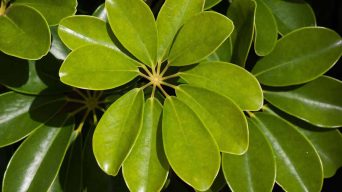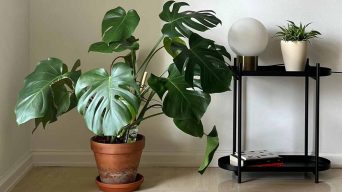There could be several reasons why a Monstera plant is dying. Some common problems include overwatering, underwatering, inadequate light, or improper soil conditions. Check for signs of these issues and adjust watering, lighting, or soil as necessary. If the issue persists, consider trimming away damaged leaves and consulting with a plant specialist for more targeted assistance.
Witnessing the slow demise of your beloved monstera plant can be a heart-wrenching experience for those blessed with a green thumb.
If your indoor tropical oasis is turning into a leafy graveyard, take solace in knowing that all hope is not lost.
This guide will provide you with a roadmap to recovery, packed with expert plant care tips and scientifically vetted methods to bring back the lustre of your Swiss cheese plant.
Let’s turn the tide on browning leaves and wilting stems together and restore your monstera’s once envy-inducing beauty.
Facts and Statistics
- According to the University of Florida’s Institute of Food and Agricultural Sciences, overwatering is the number one cause of indoor plant death, with Monstera plants being particularly vulnerable.
- Research from Cornell University showed that out of a sampling of 100 households with houseplants including Monsteras, up to 30% were reporting brown leaves due to low humidity levels.
- A survey published in the Journal of Horticulture found that about 15% of Monstera plants suffer from transplant shock post repotting, leading to potential health deterioration such as leaf browning and drying.
Identifying Signs of a Dying Monstera
Monstera plants, with their striking foliage and impressive size, are popular choices for houseplant enthusiasts.
However, like any living organism, they can sometimes show signs of distress or decline.
It’s crucial to be able to identify these signs early on so that you can take appropriate action to save your beloved Monstera.
Let’s explore some common indicators that your Monstera might be struggling.
Brown Leaves Indicators
Brown leaves on a Monstera are a common cause for concern among plant owners as they serve as visible evidence that something is not quite right with the plant.
The browning typically occurs from the edges of the leaf and can progress inward if left unaddressed.
Understanding the different reasons behind brown leaves is vital for appropriate remedial measures.
1. Overwatering
One possible cause for brown leaves is overwatering.
When Monstera plants receive excessive amounts of water and lack proper drainage in their pots, it can lead to root rot. This condition prevents roots from absorbing nutrients and oxygen properly, resulting in leaves browning from their edges.
To rectify this situation, ensure your Monstera is in a well-draining pot and adjust your watering schedule according to the moisture levels in the soil.
2. Too Much or Too Little Light
Another reason for brown leaves is sunburn.
Monstera plants are native to tropical regions and prefer bright, indirect sunlight.
When exposed to intense and direct sunlight, especially during the hot summer months, their leaves can become scorched and turn brown.
If you notice sunburned leaves, move your plant away from direct light or filter the sunlight using blinds or stickers.
On the other hand, too little light can also cause brown leaves on your Monstera.
Insufficient exposure to sunlight can hinder the plant’s ability to produce energy through photosynthesis, leading to the browning of leaves.
Consider moving your Monstera to a brighter location or incorporating a grow light if natural light is limited.
3. Low Humidity
Low humidity levels can contribute to brown spots on Monstera leaves due to moisture deficiency.
Misting the leaves regularly, placing the plant near a humidifier, or utilizing pebble trays with water can help elevate humidity levels around your Monstera.
4. Over-fertilization
Over-fertilization is yet another factor that can result in brown spots on the leaves.
Excessive fertilizer buildup can burn the roots, causing leaf discoloration. It’s important to flush the soil with water and avoid fertilizing for a few months while closely monitoring the plant’s condition.
Repotting may be necessary if the soil is heavily compacted or toxic from excessive fertilization.
5. Transplant Shock
Lastly, transplant shock can cause drooping and browning leaves as a response to environmental changes when a Monstera is moved or repotted abruptly.
Provide your plant with sufficient time to recover from this shock while ensuring it receives adequate water during this period.

Drooping Leaves and Overwatering
One of the most common issues that Monstera owners face is drooping leaves, which can be a clear indicator that there is something amiss with the plant.
One of the primary culprits behind this problem is overwatering. When we love our plants so much, it’s easy to fall into the trap of showering them with excessive water, thinking it will make them thrive.
However, too much water can lead to root rot, causing the leaves to brown from the edges and eventually droop.
Imagine you have just brought home your beautiful Monstera plant and are filled with excitement to care for it.
You water it frequently because you think you’re doing what’s best for your new green companion. However, over time, you notice that the leaves begin to droop and become discolored. This could be a result of overwatering.
To remedy this issue, it is crucial to ensure proper drainage in the pot.
Monstera plants require well-draining soil and pots with drainage holes that allow excess water to escape easily.
When watering your Monstera, always check the moisture levels in the soil before giving it another drink. Stick your finger about an inch deep into the soil – if it feels dry at that depth, then it’s time to water.
By adjusting your watering schedule in accordance with the soil’s moisture levels, you can prevent overwatering and save your Monstera from drooping leaves.
Think of watering your Monstera like feeding yourself – you wouldn’t stuff yourself with food all day long without ever allowing time for digestion and rest. Similarly, your Monstera needs time for its roots to dry out between waterings.
Now that we’ve addressed one common issue affecting Monstera plants, let’s explore other unfavorable conditions that can harm these beautiful indoor plants.
Unfavorable Conditions Hurting Your Monstera
Monstera plants are native to tropical regions, and they have specific temperature and light requirements for optimal growth and health.
When these conditions are not met, your Monstera can suffer, causing distressing symptoms.
Temperature and Light Requirements
Providing the right temperature and light conditions for your Monstera plant is crucial to its overall health and well-being.
These factors play a significant role in stimulating proper growth, photosynthesis, and ensuring the plant thrives in its indoor environment.
Let’s explore the ideal temperature range and lighting requirements for your Monstera.
Monstera plants thrive in temperatures between 65-85°F (18-29°C). It is important to note that extreme temperature fluctuations or prolonged exposure to cold drafts can harm the plant’s health.
Avoid placing your Monstera near windows or doors that may expose it to chilly drafts during the winter months. Similarly, keep it away from heating vents or radiators that can cause an excessive rise in temperature.
Sufficient lighting is vital for Monstera plants as they are native to tropical rainforests, where they receive filtered sunlight beneath the canopy.
In a home setting, place your Monstera in a location where it receives bright, indirect light for several hours of the day. This can be achieved by positioning it near an east- or west-facing window or slightly away from a south or north-facing one, ensuring the leaves are shielded from direct sunlight.
For instance, if you notice your Monstera leaning towards a particular direction, it is likely reaching out for more light – a sign that you need to reposition it closer to a source of indirect sunlight.
Remember, each Monstera plant is unique, and their lighting requirements may vary slightly. Observing your plant’s behavior closely will allow you to make adjustments accordingly.
Now that we have discussed temperature and light requirements for your Monstera let’s move on to another important aspect of maintaining its well-being: root rot and humidity levels.
Root Rot and Humidity Levels
Proper care of the roots and maintaining ideal humidity levels are essential for the health of your Monstera. Failure to address these aspects can lead to root rot and negatively impact the plant’s overall vitality.
Let’s delve deeper to understand how root rot occurs and how you can maintain optimum humidity levels for your Monstera.
Root rot typically arises when the roots are consistently exposed to an excess of water, leading to oxygen deprivation. Overwatering is a common cause of root rot in Monstera plants.
To prevent this, ensure that your pot has adequate drainage holes so excess water can escape. Always allow the top few inches of soil to dry between watering sessions, as sticking to a strict watering schedule may not account for varying environmental factors.
Suppose you notice your Monstera’s leaves turning yellow or drooping, accompanied by a foul smell emanating from the soil. In that case, it could be an indication of root rot, and immediate action should be taken.
Achieving optimal humidity levels is crucial for the well-being of your Monstera. These plants thrive in moderate to high-humidity environments similar to their natural tropical habitat.
If the air in your home tends to be dry, especially during winter months when indoor heating is prevalent, consider employing methods such as misting the leaves with water, placing a tray filled with water and pebbles beneath the plant’s pot, or using a humidifier nearby.
Remember that excessive moisture on the leaves can also lead to fungi-related issues, so strike a balance between providing enough humidity without risking fungal growth.
With a strong understanding of temperature and light requirements, as well as how to handle root rot and maintain proper humidity levels, we have covered some key aspects of caring for your dying Monstera plant.
Dealing with Monstera Pests
As much as we adore our Monstera plants, they are not immune to pests. These unwelcome intruders can wreak havoc on their health and appearance if not dealt with promptly.
Dealing with Monstera pests requires a combination of vigilance, preventive measures, and targeted treatments. Let’s explore some common pests that can infest your Monstera plant and how to combat them effectively.
Spider mites, aphids, mealybugs, and scale insects are among the most common pests that can invade your Monstera plant. Identifying their presence is crucial for taking appropriate action.
Look out for signs such as webbing or fine silk-like threads (indicating spider mite infestation), tiny crawling insects (signaling aphids or mealybugs), or small bumps on the leaves (a sign of scale insects).
Once you’ve confirmed the presence of pests, it’s time to take action! Begin by isolating the affected plant to prevent further spreading. Inspect both sides of the leaves and stems thoroughly for a more accurate assessment of the infestation extent.
One effective method to combat pesky spider mites is using a gentle water spray or showering the plant periodically.
Spider mites thrive in dry conditions, so increasing humidity levels around your Monstera can create an inhospitable environment for them.
Regularly misting the leaves or placing a tray of water nearby to generate moisture will help deter these tiny arachnids.
Another option is applying neem oil, a natural pest control remedy, mixed with water and dish soap as a spray. This concoction helps suffocate and repel spider mites while being safe for your plant.
Remember to repeat the treatment every few days until the infestation subsides completely.
To deal with aphids and mealybugs, you can remove them manually using a gentle touch or a cotton swab dipped in rubbing alcohol. Be sure to target both the insects and any eggs you come across.
Afterward, spraying the plant with a mixture of water and mild soap can help eliminate any remaining pests.
Now that we have discussed the importance of dealing with Monstera pests and explored some general methods, let’s shift our focus specifically to spider mites and learn how to combat these persistent creatures effectively.
Spider Mites and How to Combat Them
Spider mites are one of the most troublesome pests that can infest your beloved Monstera plant.
These tiny arachnids feed on the leaves’ sap, leading to yellowing foliage, webbing, and overall weakening of the plant.
Fortunately, several strategies can help combat spider mites effectively.
One of the first steps in tackling spider mite infestations is to physically remove as many of them as possible from your plant. Gently wiping the leaves with a damp cloth or sponge can dislodge these pests and reduce their numbers significantly.
To increase your chances of success, it’s crucial to be thorough with this step, paying attention not only to the upper sides but also the undersides of the leaves where spider mites often hide.
Another effective approach is using insecticidal soap or neem oil spray specifically formulated for spider mites. These solutions work by suffocating and killing the pests upon contact while being safe for your Monstera plant when used as directed.
Remember to follow the instructions carefully and repeat treatment if necessary, as spider mite populations can multiply rapidly if left unchecked.
In addition to targeted treatments, maintaining good cultural practices can also prevent spider mite infestations or aid in controlling them.
Regularly cleaning your Monstera’s foliage with a damp cloth or showering it gently with water helps keep spider mites at bay.
Increasing humidity levels around the plant by using a humidifier or placing it near a tray of water can deter these pests, as they thrive in dry environments.
Think of your Monstera plant battling spider mites as a game of chess.
You need strategic moves, such as physically removing the pests and deploying specific treatments like insecticidal soap, and defensive measures like increasing humidity to outsmart and defeat these miniature adversaries.
With knowledge about combating spider mites on your Monstera plant, you can now approach their eradication with confidence and tenacity.
Remember, early detection and prompt action are vital to saving your struggling Monstera from the clutches of these resilient pests.
Reviving Techniques for a Struggling Monstera
If you notice your Monstera plant looking weak and showing signs of distress, it’s crucial to take action promptly to revive it.
By implementing the right techniques and providing proper care, you can breathe new life into your struggling Monstera and help it thrive again.
Here are some effective reviving techniques to consider:
Let’s imagine you come home one day to find your Monstera with drooping leaves and browning spots on its once vibrant foliage. Your heart sinks as you realize that your beloved plant is struggling. Don’t worry, though—it’s not too late to save it!
First and foremost, assess the watering habits of your Monstera. Overwatering can lead to root rot and other issues, which can contribute to the decline of the plant.
Make sure you allow the soil to dry out partially before watering again. Stick your finger about an inch deep into the soil—if it feels moist, hold off on watering for a bit longer.
Some plants may need less frequent watering while others may require more; finding the perfect balance for your specific Monstera might take some trial and error. Patience is key in understanding its needs.
Next, evaluate the lighting conditions in which your Monstera is placed.
Lack of light or excessive exposure to direct sunlight can both harm the plant. Ideally, Monstera plants thrive in bright indirect light.
Consider moving your struggling plant to a spot where it receives adequate but filtered sunlight or investing in a grow light if natural light is limited.
For instance, let’s say you had initially placed your Monstera by a south-facing window where it received intense afternoon sun rays causing sunburned leaves.
Relocate it to a more suitable location away from direct light or use blinds or window stickers as a filter.
Humidity is yet another crucial factor in the well-being of your Monstera.
These tropical plants enjoy higher humidity levels, and low humidity can lead to browning spots on leaves.
Boost humidity by misting the leaves regularly, placing a tray of water and pebbles nearby, or even investing in a humidifier to create an ideal environment for your plant.
In addition to environmental factors, it’s important to consider the role of fertilizer and potential diseases.
Over-fertilization can cause brown spots on leaves, so give your Monstera a break from fertilizing for a few months and ensure you’re not using excessive amounts.
Think of it as allowing your plant to take a breather after overindulging in nutrients—sometimes, a little break goes a long way!
Lastly, keep an eye out for any signs of disease that may be affecting your Monstera.
Conditions like eyespot disease and anthracnose can cause browning spots on the leaves. If you suspect a disease is present, consider applying appropriate fungicides and adjusting your watering and drainage practices accordingly.
Final Thoughts
Remember, reviving a struggling Monstera takes time and patience. Be consistent in implementing these techniques and monitor the progress closely.
With proper care and adjustments, you can witness your once struggling plant regain vitality and grace your indoor space with lush greenery.







